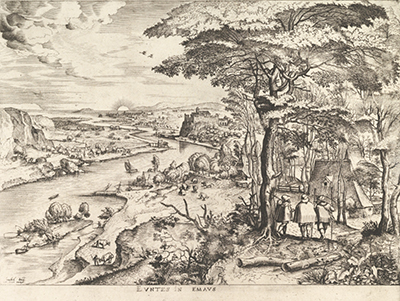The Way to Emmaus features a delightful display of the landscape abilities of Pieter Bruegel the Elder. His design was engraved and later printed the sun in to the form we find here.
We find a sweeping river cutting through much of the composition. The river is much wider in the foreground which aids the sense of perspective. A wooded tree sits to the right of the print, providing a vertical balance to the overall piece. There are several figures at the foot of this tree which also helps us to better understand the scale of the natural elements of the foreground. As we move further into the design, the land falls away to reveal an open expanse of land which is dominated by the river which heads off into the far distance. Shadows and undulating hills are key here as no tones of colour are used, contrasting to his painted landscapes such as The Hunters in the Snow.
Bruegel the Elder became known as one of the most famous landscape painters in history and was able to carry his ideas across into drawings as well. He would leave the etching and printing stages of this project to others, always remaining respectful of the work needed to master other mediums that he was not involved in. He would later hand on his legacy to his son, The Younger, who made a career out of reproducing his father's work, rarely producing his own original art. The family would spread wider into the art world for around a century before their influence ended.
A visit to the Met in New York may allow you to see the original etching block unused for this print, but check ahead to see what is on display within their European art department at the time. The institution also possess more recent art than just that of the Northern Renaissance, including movements such as Impressionism and Realism. For US followers of the great European artists, there are fewer broader collections than this, making it a must-visit gallery for those living within a short distance.




